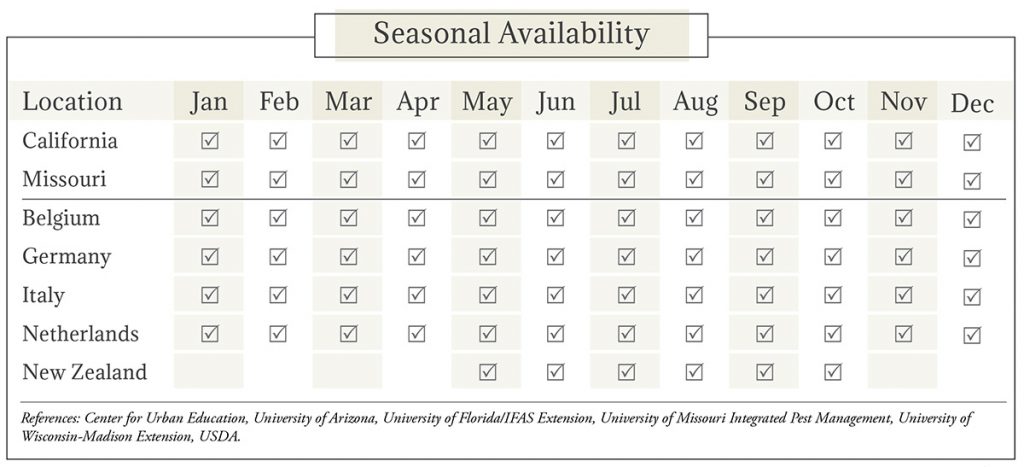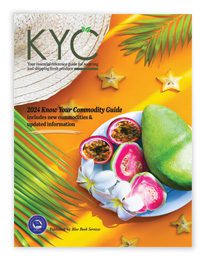Chicory Market Summary


Image: Hem Stock/Shutterstock.com
Chicory Market Overview
Chicory (Cichorium intybus) is a cool season, weedy perennial. It’s a flowering, leafy plant, part of the Asteraceae family along with daisies, dandelions, and sunflowers. Sometimes referred to as blue dandelions, it has dandelion-like leaves and a solid root used in various foods and beverages. The herbaceous plant originated in Eurasia and Africa, with reports of its use in ancient Egypt. It was later brought to the Americas by Europeans. While it is pervasive and grown in several regions, it is most often cultivated in Belgium, France, Germany, and the Netherlands. Chicory leaves are hardy and flavorful, frequently mixed with other greens into salads. They are also boiled or steamed then sautéed with olive oil as a savory side dish. Roots are boiled as a beverage additive or can be baked or grilled like other root vegetables such as parsnips or carrots. Roots are high in dietary fiber like onions, garlic, leeks, and Jerusalem artichokes. Due to its bitter, robust flavor, roasted and ground chicory root is often added to coffee (popular in New Orleans), and has been used as a cheap, noncaffeinated coffee substitute throughout history. Similarly, roasted chicory root can also be mixed into beer to accentuate taste. Chicory root is also dried, made into tea and sugar substitutes, and used for medicinal purposes, especially digestive and gut health. Plants also serve as a popular forage crop in Europe and New Zealand.
Types & Varieties of Chicory
There are numerous names within the chicory family, such as blue daisy, coffeeweed, Italian dandelion, succory, and wild endive. Cichorium encompasses several types of salad greens similar to lettuce, but with a much stronger or bitter taste. Curly endive (Cichorium endivia), a related yet distinct species, is included under the chicory umbrella, as are others like escarole as well as Belgian endive, French endive, red endive, radicchio, and puntarella (sometimes called asparagus chicory), an offshoot of Belgian endive and radicchio. Radicchio, also known as Italian chicory, is dark maroon and has white-veined leaves, while Brunswick, Magdeburg, and sativum varieties are used with or in place of coffee. Forced growing is used on certain types of chicory root, especially endive. A denser or more tight-leaf head, called a chicon, will emerge, with a crunchy, less bitter taste than traditional chicory.The Cultivation of Chicory
Chicory’s sizeable, brown, fleshy taproot supports its rugged stems (growing up to a few feet in height), with slightly fuzzy, jagged leaves. The taproot and ribs both have milky latex. The plant’s green or red leaves emerge close to the bottom of the stem, getting smaller the higher up they go. Flowers are a pretty purple-blue (occasionally white or pink) and bloom only for a day when sunny, usually between mid- to late-summer and before the first frost in most locales. Chicory fares well in cool, sunny climates with rich soil with a pH level ranging from 6.5 to 7.2. When raised in temperate regions, the crop cycle lasts about 6 months, often planted in summer or early fall. Seeds or pieces of root should be planted in deep, well-drained soil. Seedlings should be spaced out or thinned with ample watering. Mulch can fight weeds and retain moisture. Plants can tolerate low temperatures for short durations, though should be protected from frost. Harvest depends on variety. Radicchio, for example, is harvested once leaf-maturity occurs. Witloof is harvested when leaves are still small and immature, or directly prior to the final freeze of the season, if using the root. The leaves are hand-cut while roots are simply pulled out of the ground. For forced cultivation, chicory roots are harvested and further grown indoors, especially during the winter. Roots are trimmed and transplanted into a dark, warm, moist environment such as a cellar or shed. After a few weeks, plants will grow dense, blanched (due to no sunlight) chicons.
Pests & Diseases Affecting Chicory
A wide range of pests can affect chicory, including various types of aphids and beetles, cutworms, leafhoppers, leafminers, loopers, nematodes, slugs, snails, and thrips. Effects range from stunted growth and discoloration to plant death. The fungi that affect chicory include anthracnose, blight, damping-off, downy mildew, fusarium wilt, leaf spot, rust, and white mold. Bacterial diseases include yellowing, mosaic diseases, and several types of rot, such as soft, root, and bottom rot.

Storage & Packaging of Chicory
When ready for harvest, forced roots are cooled and the chicons snapped off. Greens are kept moist when moved to warmer packaging areas. Common packaging includes film-wrapped trays, cardboard containers, and perforated plastic film bags for reduced condensation. Bags are opaque or translucent to block or limit light. Storage should be dark, with 95 to 100% relative humidity, at 32°F. At 36°F, storage life is 2 to 4 weeks; at 41°F, it is 1 to 2 weeks; and at higher temps, up to a week. Chicory is sensitive to ethylene, despite producing low levels of the gas itself. Once at retail, chicons should be stored and displayed in cool, dry areas, treated much like packaged mushrooms. Loose, fresh-cut chicon leaves are sometimes included in premade salads. References: Center for Urban Education, University of Arizona, University of Florida/IFAS Extension, University of Wisconsin-Madison Extension, USDA.Grades & Good Arrival of Chicory
There is only one grade for escarole, endive, or chicory: U.S. No. 1. Plants should have similar varietal characteristics with fresh, well-trimmed and fairly well blanched leaves, free from decay and damage. There should be no broken, bruised, spotted, or discolored leaves, or evidence of wilt, dirt, disease, or insects.Generally speaking, the percentage of defects shown on a timely government inspection certificate should not exceed the percentage of allowable defects, provided: (1) transportation conditions were normal; (2) the USDA or CFIA inspection was timely; and (3) the entire lot was inspected.
| U.S. Grade Standards | Days Since Shipment | % of Defects Allowed | Optimum Transit Temp. (°F) |
| 10-5-2 | 5 4 3 2 1 | 15-8-4 14-8-4 13-7-3 12-6-2 10-5-2 | 32° |

